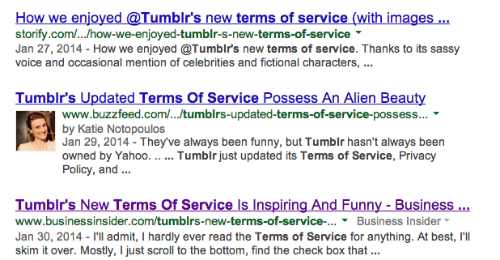Turning Old Content Into New Links
It’s no secret that in order to build good links, you typically need to build good content. The problem is creating good content takes time and resources, and after the piece has gone live and been promoted, it’s often forgotten about. What a waste! One great way to put that content to good use and […]
It’s no secret that in order to build good links, you typically need to build good content. The problem is creating good content takes time and resources, and after the piece has gone live and been promoted, it’s often forgotten about. What a waste!
One great way to put that content to good use and build new links is to revisit and repurpose. After all, if a piece was successful once, it probably was successful for a reason. Take advantage of what you already have.
Audit Existing Content

Also be sure to check out which pieces have the most inbound links. This can be done through a number of tools including Open Site Explorer, Majestic SEO or Raven Tools, to name a few.
As you’re going through your analytics, keep track of your top posts. This will become extremely handy as you start scoping out content ideas and think about promotion. Make note of the following factors (an excel sheet is great for this):
- Title
- URL
- Type of Content (Blog Post, News Story, Infographic, etc.)
- Style of Content (List, Opinion, Gallery)
- Shares
- # of Links
- Linking URLs
Once you have identified your top pieces of content, it’s time to start creating a plan and repurposing your content.
Repurpose & Reach Out
There are a number of ways to repurpose content but there are a few easy routes to take if you break your content down by type. Here are a few ideas:
1. Turn List Posts Into Slide Decks
List posts are perfect for creating slide decks. They are already concise, they contain the best pieces of information, and people tend to love them. A beautiful slide deck can result in a new piece of content both off-site and on-site, and creates a new way to generate links.
Link Opportunity: Who are the people who linked to the original post? Would they be interested in this new version? Possibly. Would they be interested if they were a part of it? I’d say it increases your odds.
Include a quote from someone who referenced the post somewhere else or add a couple slides that showcase tweets. This provides an easy in to then reach out to those people, let them know you updated the content and, more importantly, let them know you featured them in the deck.
2. Make Internal Presentations Public
One of my absolute favorite pages on SlideShare is the page dedicated to presentations about company culture. Why? Because I’m passionate about building a great company culture, and it’s fascinating to see how other companies are doing it.
Many of these presentations — which, for most companies, would remain internal — have over 10,000 views and 100+ embeds. Who knows how much traffic they are driving to blogs or company pages?
This can also be done with client presentations. My colleague Derek Edmond took a basic keyword research presentation that was created for a client and turned it into two new pieces of content: he posted it to SlideShare and followed it up by writing a post about it on the blog.
That post was shared across several platforms and even picked up in the daily SearchCap, resulting in a number of links.
This was a simple internal presentation that would’ve just sat in a folder someplace but instead, is driving traffic, links, and helping people better understand keyword research. Score!
Link Opportunity: Internal content that may not seem interesting or like a big deal to you may be interesting to other people.
3. Manage Your Microsites
Remember the days of creating hundreds of microsites simply for the purpose of building links and taking over the search results? No, me neither. While that may be a thing of the past, microsites are often created nowadays for marketing campaigns. Take for example the current Old Spice campaign featuring at least nine hilarious microsites:
These sites are great, and they are driving traffic and links. However, there’s a chance that once the campaign is over, those sites will likely be left to die along with their links, as you can see if you go to Mollydooker or Nokia. Companies can take advantage of their hard work (and money) by redirecting those microsites to the main company site.
Instead of just pointing them to the home page, though, create a landing page that reflects the campaign.
Link Opportunity: By redirecting all of those microsite links to your main site, you’re not only telling the search engines that that campaign and site were yours, you are now getting credit for it.
4. Update That Stats Post
Posts featuring a list of statistics can be extremely valuable and often draw a lot of traffic and links. Take for example this post from TopRank on “100 B2B Content Marketing Statistics for 2013.” The post has more than 350 links from 90 domains (according to Open Site Explorer) and has plenty of shares.
It also contains some phenomenal stats that will likely need to be updated for 2014.
Link Opportunity: After updating the post, reach out to those who linked to it or mentioned the original and let them know you have the 2014 numbers. Be sure to look at public shares from Twitter or Google+ to see just who shared the post and who you can interact with.
5. Make Boring Content Fun
It’s much easier to take an interesting blog post or eBook and repurpose it than it is to take your FAQ or Privacy Policy page and turn it into a link magnet. Or maybe it isn’t…
Tumblr took its Terms of Service and made it fun and interesting. On top of that, it was picked up by sites like BusinessInsider, The Daily Dot, and more.
Adroll has one of my favorite FAQs because it has a hidden gem.
The link points to one of my favorite online videos and in turn, I’ve written about it (and linked to it) multiple times. I mean come on, who doesn’t love turtles and the zombie kid?
Link Opportunity: Just because a page is typically boring doesn’t mean it has to be. Take the expected and make it unexpected.
Do It Again
Just because you were busy repurposing content and building sweet new links, doesn’t mean you weren’t creating any new content in the meantime. Make sure to go back and see what content may be able to be repurposed 3, 6, or 12 months down the road.
You never know what you’ll find, and you never know how many great links it may obtain. As my mom used to say to me, waste not, want not.
Opinions expressed in this article are those of the guest author and not necessarily Search Engine Land. Staff authors are listed here.
Related stories
New on Search Engine Land



